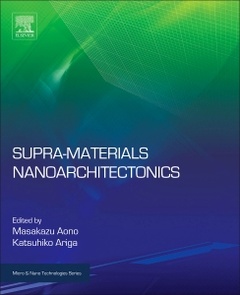Description
Supra-materials Nanoarchitectonics
Micro and Nano Technologies Series
Coordinators: Ariga Katsuhiko, Aono Masakazu
Language: English
Subject for Supra-materials Nanoarchitectonics:
Keywords
Alloy; Aqueous phase process; Aqueous solution process; Bicelles; Biomimetic morphology control; Biomimetic nanotechnology; Catalysis; Chemical sensing; Coadsorb; Colloid template; Conductive polymers; Conductivity; Conjugated polymers; Contact angle; Core�shell structure; Crystal growth; Crystals; Cyclodextrin (CD)Host�guest interaction; Dewetting; DNA origami; DNA; Dye; Dyes; Electronic and geometrical structures; Functionalization methods; Hierarchical morphologies; Hollow capsule; Hydrogels; Hydrophobic; Hysteresis; Intercalation; Liquid phase process; Luminescence; Magnetic hyperthermia; Magnetic nanoparticles; Metal oxide; Metal; Molecular recognition; Molecules; MRI contrast agent; Nanoarchitecture; Nanoassembled systems; Nanocluster; Nanocreation; Nanocrystals; Nanodevice; Nanogel; Nanomotor; Nanoparticles; Nanosheets; Nanostructures; Nucleic acid nanotechnology; Oleophobicity; On-demand release; Organic polymers; Organic-inorganic hybrid; Photoresponsive; Physical and chemical properties; Polymerization; Polymers; Precise synthesis; Self-assembled monolayer; Self-assembly; Semiconductivity; Sensor; Shape memory; Site-selective immobilization; Smart polymers; Solar cells; Solubilization; Solution-based synthesis; Stability; Stimuli responsive material; Stimuli; Superhydrophobic; Supramolecular manipulation; Theranostics; Thiolate-protected gold clusters; Watson�Crick base pairing
346 p. · 19x23.3 cm · Hardback
Description
/li>Contents
/li>Readership
/li>Biography
/li>Comment
/li>
Supra-materials Nanoarchitectonics provides the latest information on design at the nanoscale, presenting a range of the new challenges that arise as the manipulation techniques that work at the macro- and micro-scale do not work at the nanoscale. The term nanoarchitectonics, coined by Japan's National Institute for Materials Science (NIMS), describes the organized interactions required at the nanoscale, replacing the traditional structure-building approach used in materials design.
Nanoarchitectonics approaches material design via a profound understanding of the interactions between individual nanostructures and their organization. As the nanoarchitectonics paradigm fits well with the discipline of supramolecular chemistry, this book brings together these two approaches to demonstrate the potential of supramolecular nanoarchitectonics in the development of new materials, both at the nano- and macro-scale.
Part 1. Nanoarchitectonics of Basics Materials
Chapter 1. Nanocluster Science
Chapter 2. Highly Luminescent Metal Nanocluster Molecules
Chapter 3. Biomimetic Morphology Control of Metal Oxides and Their Site-Selective Immobilization
Chapter 4. Molecular Surface Arrangement to Control Dynamic Dewettability
Part 2. Nanoarchitectonics of Inorganic Materials
Chapter 5. Organic-Inorganic Hybrid Nanoarchitecture at Mesoscale
Chapter 6. Nanoarchitectonic Metals
Chapter 7. Functional Layered Compounds for Nanoarchitectonics
Part 3. Nanoarchitectonics of Bio-Materials and for Biomedicals
Chapter 8. Engineering DNA Molecules for Morphological Reconfiguration
Chapter 9. Smart Polymers With Nanoarchitectonics
Chapter 10. Crystal-Induced Nanoarchitectonics of Organic Polymer Materials
Chapter 11. Nanoarchitectonics for Cyclodextrin-Mediated Solubilization and Nanoassembly of Therapeutic Agents
Part 4. Nanoarchitectonics for Energy/Environment
Chapter 12. Nanoarchitectonics Towards Smart Chemical Sensing
Chapter 13. Nanoarchitectonics for Energy and Environment
Materials Scientists, Chemists – researchers and grad students.
Masakazu Aono is highly recognized worldwide for his many distinguished research results over 35 years in the fields of surface science, nanoscience, and nanotechnology. His research is characterized by originality for making epochal advances and by surprising results. e made with his group at RIKEN and later at NIMS pioneering contributions both with novel analytical instrumentation and in novel, advanced technologies and nanochemistry, demonstrating both astonishing scientific and technological depth and breath in "Nano".
- Written by the team that coined the term nanoarchitectonics, providing a detailed explanation of the approach and techniques of supramolecular nanoarchitectonics
- Demystifies materials design via organized interactions at the nanoscale
- Explains this new paradigm via practical scientific techniques




